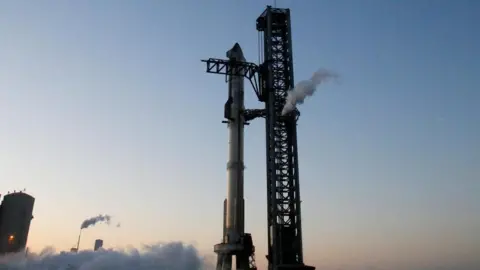The United States has grounded SpaceX’s massive Starship rocket, pending an investigation into what caused it to explode during its latest test flight.
The rocket’s upper stage dramatically split and disintegrated over the Caribbean Sea after lifting off from Texas on Thursday, forcing flights to divert to avoid falling debris.
The Federal Aviation Administration (FAA) said it was working with SpaceX and other authorities to confirm reports of damage to public property in the Turks and Caicos Islands. There were no reports of injuries.
Elon Musk’s company has been directed by aviation regulators to conduct an “accident” investigation and will review the findings before deciding whether Starship can return to flight.
The FAA confirmed it had activated a “debris response zone” that temporarily slows aircraft outside of areas where debris is falling and prevents them from leaving their departure areas.
It added that several aircraft requested diversions due to low fuel levels while waiting outside the affected area.
 Reuters
ReutersStarship is the largest and most powerful rocket ever built and is key to Musk’s ambitions to colonize Mars.
Thursday’s unmanned launch was Starship’s seventh test mission and the first involving a taller, upgraded version of the rocket.
SpaceX said before the test that Starship’s upper stage is 2 meters (6.56 feet) taller than previous versions, making it a “new generation ship with significant upgrades.”
It was scheduled to make a controlled splashdown in the Indian Ocean about an hour after liftoff from Boca Chica, Texas.
The Starship system took off at 17:38 ET (22:38 GMT), and the upper stage separated from the super heavy booster approximately four minutes into the flight as planned.
But then SpaceX communications manager Dan Huot reported on a livestream that the mission team had lost contact with the ship.
The Super Heavy Booster was able to return to the launch pad approximately seven minutes after liftoff, as scheduled, and the ground control team erupted in applause.
SpaceX later acknowledged that the upper stage had undergone “unscheduled rapid dismantling.”
In a post on social media platform
The billionaire added: “There is currently nothing to suggest that the next launch will be after next month.”
 Reuters
ReutersSpaceX’s Starship spacecraft and Super Heavy rockets (collectively referred to as Starships) are 123 meters (403 feet) tall and fully reusable, the company says.
NASA wants to use a modified version of the rocket as a manned lunar lander for its Artemis mission to return to the moon.
In the more distant future, Musk wants Starship to make long-distance trips to Mars and back, lasting about nine months.
 Reuters
ReutersThursday’s Starship test launch came hours after the maiden flight of the Blue Origin New Glenn rocket system, which was backed by Amazon President Jeff Bezos.
This was a huge step forward for Bezos and his company, which had spent years getting rockets into orbit.
Both Bezos and Musk want to dominate the spaceship market.




